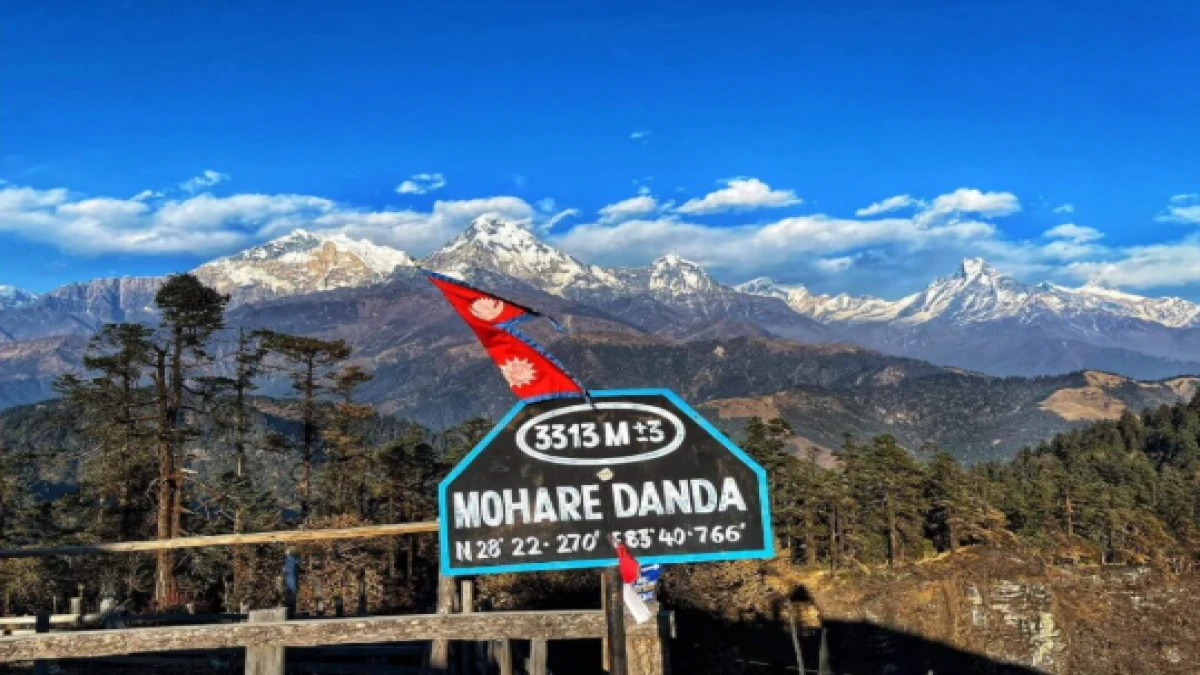Overview of Mohare Danda Trek
The Mohare Danda Trek is one of Nepal’s most rewarding short trekking adventures, offering a perfect mix of breathtaking Himalayan scenery, cultural immersion, and sustainable tourism. Over nine unforgettable days, we journey through pristine forests, terraced hillsides, and traditional villages, all while enjoying spectacular panoramas of the Annapurna and Dhaulagiri ranges. Standing at 3,300 meters, Mohare Danda is a hidden viewpoint that rivals, and in many ways surpasses, the more popular Poon Hill, yet it remains blissfully uncrowded. This is a trek where we can fully immerse ourselves in the peace and authenticity of rural Nepal.
What sets Mohare Danda apart is its community-based eco-tourism model, which channels our trekking expenses directly into local projects—supporting schools, improving infrastructure, and empowering rural communities. Instead of staying in standard tea houses, we spend our nights in community-run lodges and homestays, experiencing genuine hospitality and meals made from fresh, organic ingredients grown locally. This means every night’s rest and every meal not only nourishes us but also helps preserve the cultural and environmental heritage of the region.
The trail itself is a blend of gentle ascents, lush rhododendron forests, serene ridges, and scenic viewpoints. Along the way, we pass through picturesque Magar and Gurung settlements like Nangi, Tikot, and Bans Kharka, where traditions are still deeply rooted in daily life. We share tea with locals, witness traditional dances, and get a glimpse into the farming lifestyle that has sustained these communities for generations. While the mountains are an obvious highlight—Annapurna South, Machhapuchhre, Dhaulagiri, Nilgiri, and more- it’s the people and their way of life that leave a lasting impact.
For those seeking a short, scenic, and meaningful trekking experience, the Mohare Danda Trek offers the perfect alternative to the busier routes in the Annapurna region. It is accessible yet remote, scenic yet culturally rich, and peaceful without ever feeling too isolated. Whether you’re looking to witness unforgettable Himalayan sunrises, contribute to local development, or simply enjoy a more personal connection with the land and its people, this 9-day trek delivers it all.
Who Is This Trek For?
The Mohare Danda Trek is designed for travelers who want a peaceful, authentic, and culturally enriching trekking experience without the rush and crowds of more commercial routes. It is ideal for those who value connection over convenience and prefer meaningful encounters with local people over tourist-heavy experiences.
If you are a first-time trekker, this route is perfect because it is relatively short, has manageable daily walking distances, and does not reach extreme altitudes. It is also suitable for families or small private groups who want to explore the beauty of the Annapurna region without worrying about hectic trails. Experienced trekkers will appreciate Mohare Danda for its off-the-beaten-path charm and its focus on eco-friendly tourism, offering a refreshing change from mainstream trekking routes.
For those who wish to combine stunning Himalayan panoramas with genuine cultural immersion, this trek is unmatched. Every day on the trail allows us to interact with Magar and Gurung families, experience their traditions, and enjoy farm-fresh meals—all while trekking through landscapes that shift from river valleys to lush forests and panoramic ridgelines.
Why Is This Trek Better Than Other Short Treks?
While popular short treks like Poon Hill and Ghorepani offer beautiful mountain views, they also come with large crowds, especially during peak seasons. Mohare Danda, on the other hand, offers equally—if not more—spectacular scenery with far fewer people. This allows us to enjoy peaceful moments at viewpoints, take uninterrupted photographs, and truly connect with nature.
Another advantage is the community-based tourism model. Unlike other treks where profits often flow to private lodge owners, the Mohare Danda Trek ensures that most of our spending directly benefits local communities. This means that every step we take supports sustainable livelihoods, education, and conservation projects. Lastly, the diversity of experiences makes Mohare Danda stand out. The trail offers rich cultural encounters, diverse landscapes, and the rare opportunity to stay in eco-lodges built and managed by locals. It’s not just about reaching a viewpoint; it’s about becoming part of the community, even if only for a few days.
Final Thoughts
The Mohare Danda Trek is not just another Himalayan trekking route; it’s a journey into the heart of Nepal’s natural beauty and cultural heritage. In just nine days, we experience the full spectrum of what makes the Annapurna region extraordinary: snow-capped peaks glowing in the sunrise, lush rhododendron forests, ancient stone villages, and the warm smiles of the Magar and Gurung people. What makes this trek truly special is its commitment to sustainable, community-based tourism. Every step we take, every night we stay in a local eco-lodge, and every meal we share directly supports rural communities and helps preserve the landscapes we admire. It’s a rare chance to travel responsibly while still enjoying all the comforts and beauty that a Himalayan trek offers.
Whether you are a first-time trekker seeking an accessible introduction to the Himalayas or an experienced adventurer looking for a quieter alternative to crowded trails, Mohare Danda delivers. Its peaceful trails, breathtaking panoramas, and genuine cultural encounters leave us with more than just photographs; they leave us with memories, friendships, and a deeper connection to the mountains and people of Nepal. If you want a trek that combines scenery, serenity, and social impact, the Mohare Danda Trek is an adventure worth taking, not just for the views, but for the stories you’ll bring back and the difference you’ll make along the way.


 based on 11 reviews
based on 11 reviews
